|
|
|
Sort Order |
|
|
|
Items / Page
|
|
|
|
|
|
|
| Srl | Item |
| 1 |
ID:
182687
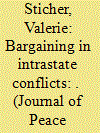

|
|
|
|
|
| Summary/Abstract |
Research shows that conflict parties engage in ceasefires in pursuit of a variety of objectives, some of which reduce while others fuel violent conflict. This article provides a framework that links these objectives to a larger process. Building on bargaining theory, three distinct bargaining contexts are specified for intrastate conflicts. In the Diminishing Opponent context, leaders believe that a military solution yields a better outcome than a political settlement. In the Forcing Concessions context, they recognize the benefit of conflict settlement, but expectations about a mutually acceptable agreement still widely diverge. In the Enabling Agreement context, expectations converge, and leaders seek to pursue settlement without incurring further costs. In line with these readings, conflict party leaders adapt their strategic goal, from seeking to set up a military advantage, to boosting their bargaining power, to increasing the chances of a negotiated settlement. They may use ceasefires in the pursuit of any of these three goals, shifting the function of a ceasefire as they gain a better understanding of bargaining dynamics. A comparison of violence and ceasefire patterns in six contemporary peace processes and a congruence test conducted on the 2012–16 peace negotiations between the Colombian government and the guerilla organization FARC offer support for the theoretical framework. The findings highlight the important, and shifting, role ceasefires play in the transition from war to negotiated peace.
|
|
|
|
|
|
|
|
|
|
|
|
|
|
|
|
| 2 |
ID:
178376
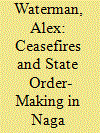

|
|
|
|
|
| Summary/Abstract |
The 1997 Indo–Naga ceasefire is one of the world’s longest truces. Although formally-agreed rules technically regulate the state-rebel relationship, the rules themselves and their applicability beyond the Indian state of Nagaland are ambiguous and open to interpretation. Far from static, the ceasefire represents an evolving cluster of ‘armed orders’ oscillating between coexistence and limited conflict [Staniland, Paul. “Armed Politics and the Study of Intrastate Conflict,” Journal of Peace Research 54, no. 4 (July 1, 2017): 459–67. doi:10.1177/0022343317698848]. Indian state actors display intriguing variations in their approaches towards these orders, from restraint and de-escalation in some circumstances to aggressive local counterinsurgency in others. To date, however, existing research on order within ceasefires focus on rebel perspectives. Building on existing efforts to reconceptualise ceasefires as arenas in which political order is negotiated and constructed, this article re-introduces the state’s role in order-making, locating these processes within wider rebel and non-state attempts to do so. Analysing armed orders in the Naga ceasefire, it reveals a fascinating spectrum of bargaining, signalling and negotiation over the formal and informal rules of armed orders. This challenges the notion that ceasefires simply lock in state-armed group orders, but instead create new spaces for armed order’s renegotiation.
|
|
|
|
|
|
|
|
|
|
|
|
|
|
|
|
| 3 |
ID:
193110
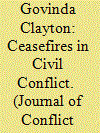

|
|
|
|
|
| Summary/Abstract |
Ceasefires are arrangements through which conflict parties commit to stop fighting. They are a common part of intra-state conflict. Existing research on intra-state ceasefires is largely limited to case studies and guidance notes for the policy and practice community. What has to date been lacking is a complementing body of comparative quantitative analysis to identify broader ceasefire trends and test the wider applicability of theory. Recent advancements in ceasefire data offer new opportunities to broaden the research agenda on ceasefires. This special section sets out the current state of the art in ceasefire research and provides the intellectual foundations to advance a new sub-field of quantitative ceasefire research. We discuss the conceptual challenges facing the study of ceasefires, offer a brief overview of ceasefire research focusing on the functions, timing, and sustainability of arrangements, and discuss the collective contributions of the articles included within this special section, and the implications for research and practice.
|
|
|
|
|
|
|
|
|
|
|
|
|
|
|
|
| 4 |
ID:
193111
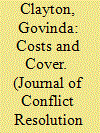

|
|
|
|
|
| Summary/Abstract |
Ceasefires are common in civil conflict. Yet we have surprisingly little comparative analysis of why and under what conditions they occur. A ceasefire provides temporary relief from the costs of conflict, but also generates its own costs. Building on this logic, we argue that conflict parties are more likely to accept the costs associated with a ceasefire when the conflict costs are greater, in particular, when: violence is intense; there are higher levels of ‘collateral damage’; and the parties lack international support. Second, we contend that ceasefires are also more likely in those periods in which the audience costs associated with entering into an arrangement are lower, specifically, when the parties have some form of ‘political cover’, such as during mediation. We find support for both arguments in an analysis of a new dataset capturing all ceasefire in civil conflict from 1989-2020, using a series of dyad fixed effect models.
|
|
|
|
|
|
|
|
|
|
|
|
|
|
|
|
| 5 |
ID:
178373
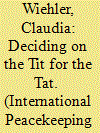

|
|
|
|
|
| Summary/Abstract |
Ceasefires are agreed in most intra-state conflicts and the majority of these agreements are violated. Yet, the subsequent dynamics of retaliation are still poorly understood. This article proposes a novel conceptual framework, describing the decision-making of conflict parties after ceasefire violations. I argue that the conflict parties face the two-fold decision-making problem of choosing a proportionate reaction: a reaction that assures their interest in the ongoing conflict and in the continuation of the agreement. When proportionate reactions are chosen, mutual compliance with the ceasefire can be re-established. The empirical implications of this framework are illustrated with evidence from two ceasefires in the Mindanao conflict in the Philippines. This article advances our analytical understanding of an overlooked period during armed conflict, i.e. while a ceasefire is in place. This is critical since collapsing ceasefires can lead to a deterioration of the humanitarian situation and of the prospects for peace. More generally, this article draws the attention to the counter-intuitive function of violence to secure cooperation in intra-state conflicts.
|
|
|
|
|
|
|
|
|
|
|
|
|
|
|
|
| 6 |
ID:
152023
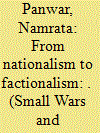

|
|
|
|
|
| Summary/Abstract |
Do ceasefires or peace talks create fragmentation in the insurgent groups? Rather than proposing claims that can offer predictions about armed groups behaviour under ceasefires or peace processes, the analysts tend to focus largely on the dynamics between state and non-state actor. The experts pay little attention to overtime changes in social and local political context which might contribute to propelling a rebel group towards fragmentation and factionalism. The present study intends to fill this gap by exploring the shifting role of public opinion and ethnic support for the peace talks to ascertain whether it can increase the likelihood of factionalism in rebel groups or not. This article applies this approach to the case of Naga National Movement (1947–2015) in India, and finds that the proposed variable appears to have increased the frequency of factionalism in the movement.
|
|
|
|
|
|
|
|
|
|
|
|
|
|
|
|
| 7 |
ID:
180887


|
|
|
|
|
| Summary/Abstract |
Completed negotiations often end in shortfalls, half glasses, and way stations. Is that enough to claim success and is a half-loaf sometimes sufficient? The nine articles in this thematic issue examine various forms of incomplete negotiations, from a full-worded agreement that is bypassed, through a formal ceasefire, an agreement among only the agreeables, a mediated but non-transforming agreement, a confidence-building agreement, and finally, claimed resolution that drives violence underground. Sufficiency has different meanings in each case, but generally refers to making some progress in handling the conflict, whereas insufficiency refers to not making progress at any level that is lasting.
|
|
|
|
|
|
|
|
|
|
|
|
|
|
|
|
| 8 |
ID:
193116


|
|
|
|
|
| Summary/Abstract |
This article introduces the Civil Conflict CeaseFire (CF) dataset. The CF data covers all ceasefires in civil conflict between 1989 and 2020, including multilateral, bilateral and unilateral arrangements, ranging from verbal arrangements to detailed written agreements. In total, the CF data includes 2202 ceasefires across 66 countries and 109 civil conflicts. The data feature information on the actors involved in the ceasefire, and the class, purpose, coverage, and end date of the ceasefire. The CF data provide an empirical basis to assess the conditions that give rise to ceasefires, how ceasefires affect the dynamics of conflict, and the role of a ceasefire in the peace process. This article presents the rationale underlying the data collection, the coding rules and procedures, and how this data can be used for analysis.
|
|
|
|
|
|
|
|
|
|
|
|
|
|
|
|
| 9 |
ID:
193113
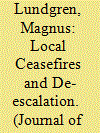

|
|
|
|
|
| Summary/Abstract |
Local ceasefire agreements are prevalent in modern civil wars, but we know little about their impact. This study analyzes geo-referenced data on 145 local ceasefire agreements declared during the Syrian Civil War, 2011-2019, exploring their short- and long-term effects on the intensity of armed violence. Drawing on scholarship on gradual confidence-building processes, we theorize the conditions under which local ceasefire agreements may generate trust and reduce conflict intensity. Using interrupted time-series analysis and spatial panel regression, we examine factors relating to the design and strategic context of ceasefire agreements. We find that local ceasefire agreements can trigger both escalation and de-escalation in the short term. De-escalatory outcomes are more likely in the long-term, when ceasefire signatories share a history of previous interaction, and when ceasefires are implemented in a stepwise fashion. We also find evidence of spatial diffusion: local ceasefire agreements in one area reduce conflict intensity in neighboring areas.
|
|
|
|
|
|
|
|
|
|
|
|
|
|
|
|
| 10 |
ID:
179931
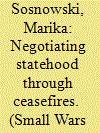

|
|
|
|
|
| Summary/Abstract |
This paper examines how ceasefires can influence elements of statehood. It adds to scholarship that views statehood as being in a continuous process of change by conceptualising international ceasefires as the negotiation of an embryonic type of wartime order that has ramifications for how power and authority are dispersed among competing actors in civil war. Through the example of the Syrian de-escalation zones, the paper suggests that the ceasefire not only affected the use of violence but recalibrated relations between international and local actors for control over diplomacy, security, territory, and citizenship.
|
|
|
|
|
|
|
|
|
|
|
|
|
|
|
|
| 11 |
ID:
180891
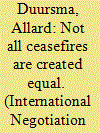

|
|
|
|
|
| Summary/Abstract |
Past research has found that third party pressure makes the signing of a ceasefire more likely, but also more likely to break down. What explains this variation? I argue that third party pressure is more likely to lead to a durable ceasefire if pressure is applied to persuade the conflict parties to continue to negotiate and produce a detailed ceasefire document, whereas pressure solely aimed at making the conflict parties sign a ceasefire document undermines the durability of the ceasefire. A comparison of four ceasefires concluded in Sudan supports this argument. Third party pressure that led to the Nuba Mountains Ceasefire and the Agreement on Security Arrangements helped move the negotiations on security arrangements forward. By contrast, the N’Djamena Ceasefire Agreement and the Darfur Peace Agreement were imposed on the parties without regard for political and technical aspects of the ceasefire. This explains why violence soon resumed.
|
|
|
|
|
|
|
|
|
|
|
|
|
|
|
|
| 12 |
ID:
128551
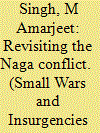

|
|
|
|
|
| Publication |
2013.
|
| Summary/Abstract |
Soon after India attained its independence from British colonial administration in 1947 the Nagas started waging an armed conflict against India to establish a sovereign independent state in Nagaland in the country's Northeast region. The conflict is today one of the world's longer running and little known armed conflicts. India's central government has tried unsuccessfully to tackle the problem through political reconciliation, use of force, and several development measures. Over the years, it has also undergone several changes in which the situation of conflict deepened whenever India's central government intervened. And yet, the road ahead also faces severe challenges because the demand for bringing the Nagas of India together into a single political entity will not go unchallenged from other ethnic groups. Moreover, a bitter leadership battle divides the Naga rebels and hence any future agreement is likely to be difficult due to factional politics as have happened in the past. Thus one way to satisfy the aspirations of different ethnic groups while protecting the boundaries of the existing states in India is to explore the option of cultural autonomy. This idea is not entirely new, but has lost significance over the years.
|
|
|
|
|
|
|
|
|
|
|
|
|
|
|
|
| 13 |
ID:
175657
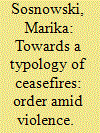

|
|
|
|
|
| Summary/Abstract |
Traditionally, ceasefires have primarily been seen as military tools used to halt violence for specific periods of time or as a teleological bridge between war and peace. Drawing from the literature on complex political order, this paper argues that rather than only affecting levels of violence ceasefires can be better conceptualised as particular types of wartime order and that consequently they can have diverse military and political consequences on the ground. These may include for recognition and legitimation, rebel governance, economic networks, state consolidation and rights to citizenship and property. The article uses this broader conceptual foundation and an analysis of 186 ceasefire agreements to create a typology with four different types of ceasefires and theorise about their potential ramifications for other contested areas beyond the military arena. It illustrates the different types of ceasefires from the typology with empirical examples from the Syrian civil war.
|
|
|
|
|
|
|
|
|
|
|
|
|
|
|
|
| 14 |
ID:
193112
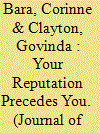

|
|
|
|
|
| Summary/Abstract |
How does the state’s behavior in negotiations with one non-state group influence the behavior of other non-state actors? We argue that the dynamics of different conflicts within the same country are interdependent, and that a state develops a reputation through its interactions with each conflict party. This reputation provides a valuable source of information that other groups use to judge the state’s cooperative intentions. When a state develops a reputation for cooperation, this increases the likelihood of (indirect) reciprocation from other groups. More specifically, we argue that when states enter into (and honor) a ceasefire with one rebel group, they demonstrate a credible reputation for cooperation. A credible reputation for cooperation, we posit, increases the likelihood that other conflict parties enter into ceasefires with the state, or that they de-escalate their military activities. We test our claims using the new civil conflict ceasefire dataset and find support for our argument.
|
|
|
|
|
|
|
|
|
|
|
|
|
|
|
|
|
|
|
|
|